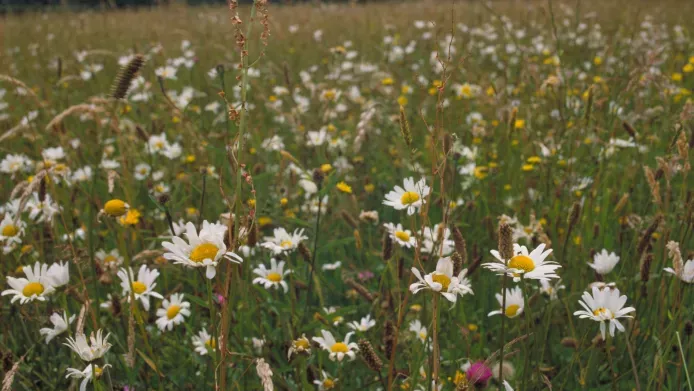Learn how to tell your corncockle from your cornflower with our ID tips and tricks

There are some plants we all know at first glance – the bright red poppy, or the tiny daisy – but could you tell the difference between upright hedge parsley and burnet saxifrage? If you came across a beautiful wildflower, on a walk in a woodland or amongst unmown grass in your local park, how would you go about finding out what it is?
Questions you should be asking involve the shape, colour and scent of the plant’s leaves and flowers. Get specific – are its leaves smooth or prickly? How are the flowers arranged on the stem? Does it have a distinctive smell?
Resources for identifying wildflowers

We’ve created a wildflower ID template to help you, and your friends and family, look at wildflowers more closely and to help you begin to build a botanical vocabulary. It’s not intended to be exhaustive, but we hope it will help you pay closer attention to wildflowers and develop the eyes, and nose, of a botanist!
This template assumes that you’re looking at wildflowers in bloom during the summer months, and that’s a very good place to start when you’re learning to identify wildflowers.
Print out some copies, share them around, and work through the template next time you’re out and about.
You’ll soon realise that there’s far more to wildflower identification than just looking at colour!
Download our wildflower template:
GrowWild_Wildflower_ID_template.pdf
Once you’ve noted down the details of your unknown specimen, have a look through our wildflower gallery and compare your notes with some of the plants on the list.
Corn Marigold
Corn Marigold Factsheet.pdfMusk Mallow
Musk Mallow Factsheet.pdf
Yarrow
Yarrow Factsheet.pdf
Corn poppy
Corn Poppy Factsheet.pdf
Red campion
Red Campion Factsheet.pdf
The Wildlife Trust
More guides to wildflowers.
The Botanical Society of Britain and Ireland
Tips to get started in botany
A questionnaire on key plant characteristics to help you identify your flowers: Flora Search
Plantlife
Spotter sheets sorted by month and habitat.
Plants of the World Online
Plants of the world online is Kew’s digital record of plants from around the world. This record is searchable by description as well as name.
The Wild Flower Key by Francis Rose
The Collins Wild Flower Guide by David Streeter
Wild Flowers by Simon Harrap
The iNaturalist app can help you to identify plants, but also record and share what you’ve found with a community of scientists and enthusiasts around the world.
Find out more and download the iNaturalist app.
Where can I see wildflowers in the UK?

Walk through a wild landscape and you enter a spectacular, vivid and exciting world. A world alive with butterflies and bees, rich in colours and scents that evoke memories of summer.
Wildflower habitats are hugely varied – marshy pasture, mountainous landscape or traditional hay meadow – but wildflowers all do best in lightly managed or natural locations. Sadly, many fields and pastures where they once grew have vanished but, although under threat, there are still places where they can be enjoyed.
Find out where Grow Wild's community projects are and if they're open to the public on our project map. (link)
-
Askrigg Bottoms Meadow, Yorkshire Dales National Park
-
Ben Lawers, Killin, Stirlingshire
-
Cricklepit Mill, Exeter, Devon
-
Merry’s Meadows, Greetham, Rutland
-
Minnowburn, Belfast, County Down, Northern Ireland
-
National Botanic Garden of Wales, Llanarthne, Carmarthenshire
-
New Grove Meadows, Monmouth, Gwent
-
Oxburgh Hall, Swaffham, Norfolk
-
Queen Elizabeth Roof Garden, Southbank Centre, London
-
Wakehurst Place, Ardingly, West Sussex